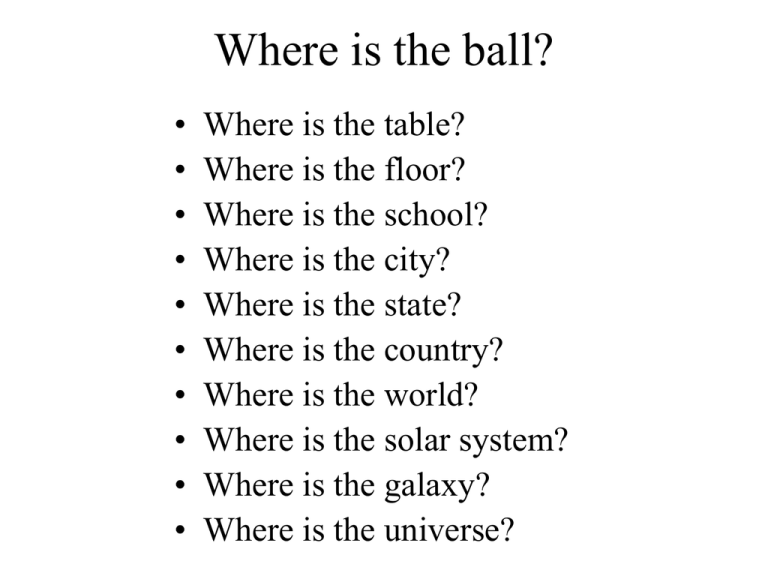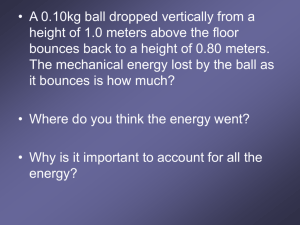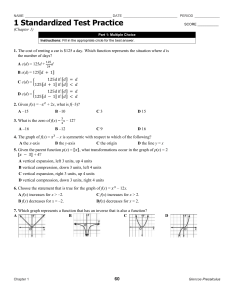File
advertisement

Where is the ball? • • • • • • • • • • Where is the table? Where is the floor? Where is the school? Where is the city? Where is the state? Where is the country? Where is the world? Where is the solar system? Where is the galaxy? Where is the universe? We can’t say where anything is without saying where something else is! • But what exactly is “where”? • Where describes the position of some object as compared to the position of some other object. • But what does position mean? • Position – A point in space compared to some other point in space. Position. The details. • The problem is that we don’t know what some of the terms in this definition really mean. • For example: What, exactly, is a point, and what is space? • Point – This is a mathematical point that has no dimensions. A point is a spatial (having to do with space) marker. What is space? • This space is a not just outer space, or inner space, or empty space. Space is all space. • Make a three dimensional coordinate system and stretch the axis out to infinity. You have just identified all of space. • Note that space can be filled (like the inside of this table top), or empty. y z x What is compared? • Compare – to show the similarities and differences between two or more different things. • In physics we have another word for compared. This word is similar to the word we have for Fathers, and mothers, and brothers, and sisters. • Relative – Compared to. This gives us a revised definition for position. •Position – A point in space relative to some other point in space. What is time? • Time is not the moment, second, minute, hour, day, year etc. • Those are terms used to describe how we measure time. • They don’t tell what time is. • What are some other ways in which we tell time? Write down the things you’ve done today, in order, up till now. • What does that list have in common with all the ways we measure time? • What is another word for the “things” you did today? • If the best band in the world were coming to town today, that would be a major __?__. • Note: Not all events are major. • Event –something that happened. • The second hand goes from the 12 to the first click after the twelve. One second, event # 1. Etc. • So, what we did was to order our events of our day. Just like the clock does. So what is time? •Time – The ordering of events. Motion! • Describe what happens when some thing moves. It goes (lets say) from position A to position B A B What about time? • Can an object move from point a to point b without time passing? • NO! • Nothing can occupy two different positions at the same time! • This means that if the position changes, the time must also change. Motion defined! •Motion – the change in position with respect to the change in time! Is the ball on the table moving? • By the definition of motion, you can see that the ball is not moving because its on the same spot on the table. • But the table is on the earth, and the earth is moving around the sun, and the sun is moving around the galaxy, and the galaxy is moving through the universe! This ball is really moving! • But no, its still on the same spot on the table! • How do we resolve this dilemma! The answer is not a simple yes or no! • Compared to the table, the ball is not moving. Compared to the sun the ball is moving. • What was the word for compared to? • To answer the question, we must speak of relative motion! • The correct answer is: • Relative to the table, the ball is NOT moving. • Relative to the sun, or any non-earth astronomical entity, (or really any thing that is moving relative to the ball) the ball IS moving! You can’t tell! • Put your hands in front of your eyes so all you can see is the whiteboard and me. • As the white board moves behind me you can’t tell if the white board is moving or if I am moving. Except, of course, you know the white board can’t be moving so it must be me that is moving, so your brain convinces you of that. What’s the difference between these two types of motion? Yes! The old car is moving slower than the other car! The change in position of the slower car took a greater change in time. But how fast is fast, and how slow is slow? • Let’s put numbers on fast and slow. • Lets use a mathematical equation to figure it out! • How would you do it? • Let’s call how fast or slow something moves its speed. • Speed is the change in position divided by the change in time. Lets write that mathematically! • Speed = the change in position / the change in time. • That’s too long to write out for as many times as we are going to use it. Our hands will ware out. • Lets abbreviate! Any suggestions? • We need letters for speed, time, position, and “the change in.” • What would you choose? S, x, & t • The scientists in this country have chosen the above. We will use those abbreviations too, so we can communicate with the other scientists across the country. • S for speed • x for position. Because x is the position marker in math. • t for time. • But how should we represent “the change in?” The change in. Trace around, and the sides keep changing! Start here • is the Greek upper case letter delta. • From now on, will mean “the change in” • Actually, we will use the Greek alphabet to represent several different terms in physics. We do this because we have more terms than there are upper and lower case letters in the English alphabet. Rewrite the equation. • We can now write: • Speed = The change in position / The change in time • As: • S = x / t • And that saves a lot of writing! What does “the change in” mean mathematically? • Mathematically, the change in means: • The final value – the initial value • We can abbreviate this by putting a subscript f for final and a subscript i, or 0 for initial. Like this: • xf – xi , or xf – x0 , or tf – ti , or tf – t0. • You will have to get use to using either i or 0 for the initial value. The reason we use both is because the starting value is the initial value, and we often try to start at 0 to make the math easier. How do we use this? • The equation S = x / t can now be written: •S = (xf – xi ) / (tf – ti ) Yes, but how do we use this? • Lets say you go from here to your grandma’s house and it takes you 4 hours to get there. Lets also say its 200 miles to your grandma’s house. How fast did you go? That is to say: How much did you change your position in that much time? Step one. • Write the equation. • S = (xf – xi )/ (tf – ti ) • Step two: • Solve the equation algebraically for the unknown using only the lettered variables. Do not use numbers yet! Except for 0. • Step two is already done in this case. Except that you can decide that xi, and ti are equal to 0. So rewrite as: • S = (xf – 0) / (tf - 0) so S = xf / tf Step 3. • Now plug in the numbers. • What value should be substituted for the final position (xf )? • That’s right! 200 mi. • What value should be substituted for the final time (tf )? • That’s right! 4 hrs. • Rewrite the equation with the numbers: • S = 200mi / 4 hrs Step 4. • Do the math! • In this case we need to divide 200mi by 4hrs. 200 mi / 4 hrs. This, you should be able to do in your head. • If you use the calculator, remember the rule: • The one on top gets punched in first! • That is to say: Type in 200, then type the divided by sign (÷), then type 4, then type the equal sign (=), or return, or enter (depending on the calculator). • The answer in this case would be 50. Step 5. • We have one more step because the answer is not just 50. • 50 what?: Micrometers per nanosecond? Or did we go 50 pounds to grandma’s house? Could we have gone 50 acres to grandma’s house. Does it make a difference? • Yes it does! • Step five: Include the units! • In this case, the units are miles per hour. Since per means to divide, we can write the units as mi /hr. So the final answer is: • S = 50 mi / hr Let’s review. • Step A – Write the givens, and unknowns. • Step B – Write the base equation. Based on the givens and unknowns • Step C – Solve the equation for the unknown. Don’t use numbers yet! (Except 0 in some cases). • Step D – Now plug in the numbers. Do the math. Make sure your calculator is in the right mode. Include the units! This helps you check to see if you got the right answer. Your turn! • Solve these problems, and then share the answers. • Travel 10 meters in 2 seconds. Find speed. • Start at 5 meters, finish at 20 meters. When starting your watch says 2 sec. When finished your watch reads 5 sec. Find speed. • You travel at a rate of fifty m/s for 40 s. How far did you go? • You travel at a rate of 100 m/s for 5000 m. How much time did you spend traveling? • S = 40 m/s. Initial time is 5 sec. Final time is 15 sec. Initial position is 30 meters from home. Find your final position from home.









